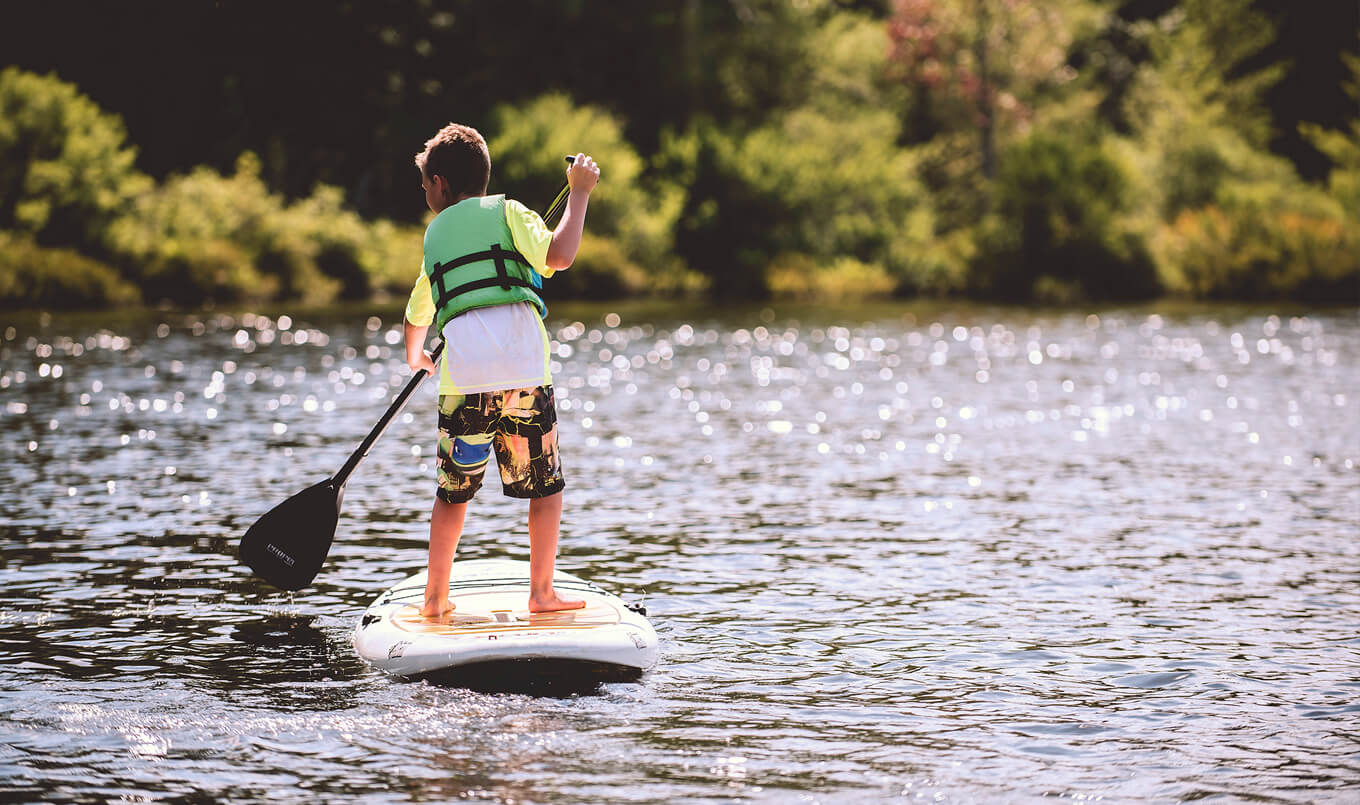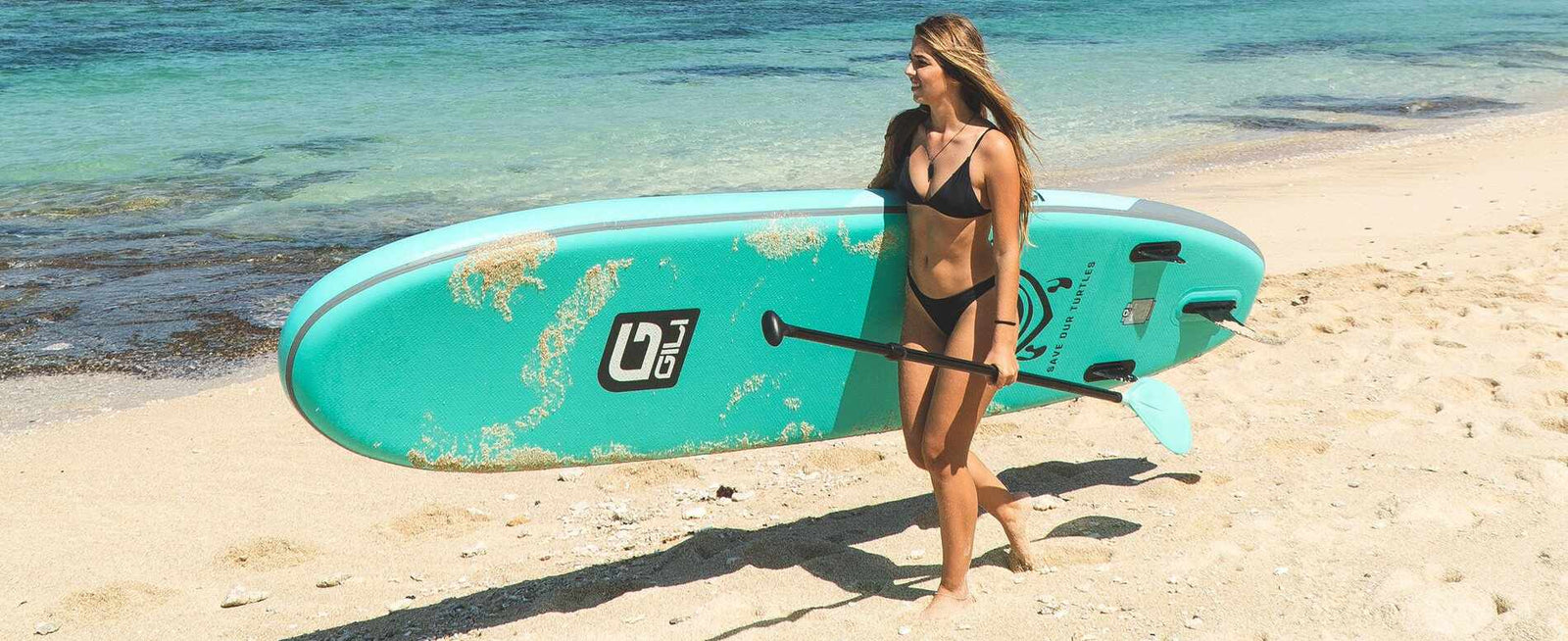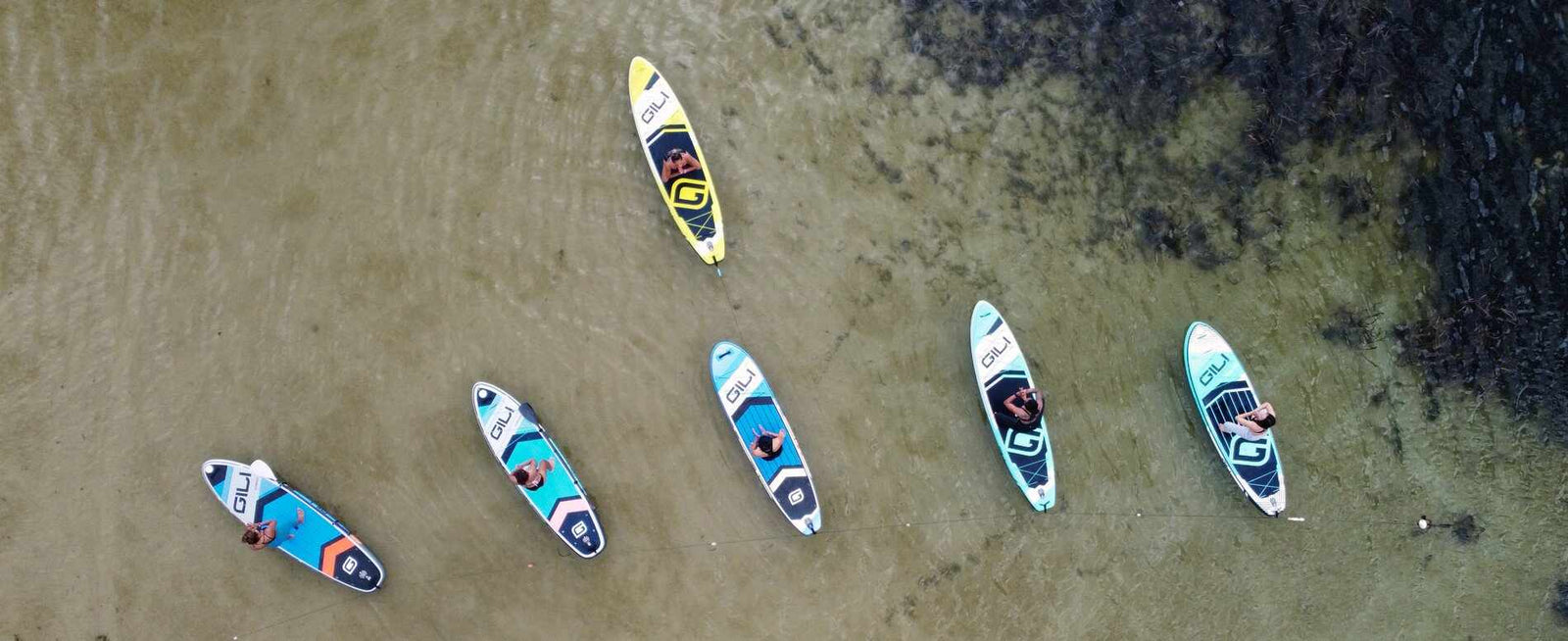Your Cart is Empty

SUP Clothing: What To Wear Paddle Boarding: All Seasons (2020)
Stand Up Paddle Board Clothing
Contrary to popular belief, stand up paddle boarding is not just a summer sport. You can hop on your board year-round - as long as you have the right clothing. As the Swedish like to say, “there is no bad weather, only bad clothes.” If you’re a SUP beginner with no clue what to wear or just new to cold-weather SUP, we’ve got you covered. Here’s everything you need to know about SUP attire.
Topics Covered in this Article
- 1. The Most Important Thing To Wear On Your Paddle Board: a PFD
- 2. What To Wear While Paddle Boarding In The Summer
- 3. What Do You Wear For Paddle Boarding In The Winter?
- 4. What To Wear While Paddle Boarding In Spring And Fall
- 5. Do You Need Shoes for Paddle Boarding?
- 6. What To Wear For SUP Yoga
- 7. What To Wear For Whitewater & River SUP
- 8. What To Wear For SUP Fishing
- 9. SUP Sun Protection
- 10. Awesome Add-Ons
The Most Important Thing to Wear on Your Paddle Board: a PFD
The most vital thing to wear on your paddleboard is safety gear - especially a PFD, or personal flotation device.
Personal Flotation Devices
If you’re paddling in the US, you should know that the US Coast Guard considers your board to be a vessel, so you’ll need a USCG-approved life jacket. Rules vary elsewhere in the world, but no matter where you are, it’s important to put safety first.

If you’re paddling with kids, make sure they’re always wearing a life jacket. As an adult, you have the option to have a life jacket or a compact PFD that can be worn around your waist. If you’re paddling with pets, don’t forget to make sure they have PFDs too!
Leashes
A leash attaches to your ankle and your SUP to keep a tether between you and the board. That way, if you fall into the water, your board won’t float away and leave you stranded.
What To Wear While Paddle Boarding In The Summer
When you’re paddle boarding in the summer, just about anything goes. You can wear a few light layers or paddle in just a swimsuit. It’s up to you!
For Women
If it’s hot out and you plan to dip into the water for a swim, SUP in just a swimsuit is totally fine. If you plan on wearing a few different layers, you’ll probably still want to wear a swimsuit underneath. You’ll also want to bring shorts with you, a hat, sunglasses, and a light overshirt to stay warm in case of a breeze. Wear a rash guard over your swimwear, both for sun protection and to feel more comfortable (more on that in a second.)

For Men
Guys, you’ll want to wear board shorts or swim trunks so you can hop into the water anytime you want. You’ll also want to have a rash guard or t-shirt, and a light long sleeve shirt in case you get cold. A hat and sunglasses keeps the sun out of your eyes and your face protected from the sun.

Why Rash Guards Are a Good Idea for SUP
Paddle boarding - and the wind and saltwater exposure that comes with it - can cause chafing and skin irritation. Rash guards can help prevent that, and on top of it, they offer excellent SPF protection.
You want to make sure your rash guard fits snug, and make sure you’re choosing one with flat-lock stitching and six-panel construction for a more comfortable fit. In the summer, you’ll probably prefer a short sleeve or tank top rash guard.
There are several different rash guard materials available:
- Neoprene: Stretchy and insulated. Excellent for cold weather.
- Nylon/Spandex: Dries quickly, and provides lots of breathability on hot days.
- Lycra: The stretchiest of options, so it will mold tightly to your body.
- Polyester: The most breathable, but what you gain in breathability, you compromise in stretchiness.

What Do You Wear For Paddle Boarding In The Winter?
Winter paddle boarding is all about preparation. As long as the water isn’t so cold that falling in would be life-threatening, you’re good to go. (Seriously, you can even SUP in destinations like Alaska.)
First things first: you’ll want to learn a thing or two about wetsuits. Not every winter SUP adventure requires one, but they’ll keep you a lot more comfortable on cold days. A neoprene wetsuit traps a tiny bit of water between your skin and your suit, and that water is warmed by your body heat to keep you nice and toasty.
Wetsuits 101
The most important factor when it comes to wetsuits is fit. You’ll want it to fit tight on every part of your body. Most people wear rash guards underneath their wetsuits to stave off skin irritation, so make sure your wetsuits still fits with that extra layer beneath it. Make sure the arms and legs of the suit go all the way to the ends of your limbs, stopping right before your hands or feet.
The thicker your wetsuit is, the warmer it will be. There are five different thickness options to choose from, ranging from about 4-6mm. Let’s take a look at which width and gear is best for each temperature:
50°F / 10°C Weather
- 3-4mm Thick Wetsuit
- 3mm Thick Neoprene Booties
- Neoprene Gloves
30°F / -1C° Weather
- 4-5mm Thick Wetsuit With A Hood
- 5mm Thick Neoprene Booties
- Neoprene Gloves
10°F / -12°C Weather
- 5-6 mm Thick Wetsuit With A Hood
- 7 mm Thick Neoprene Booties
- Neoprene Gloves

Wetsuit Alternatives
If you’re not into wetsuits or don’t want to spring for their hefty price tags, there are other options. As long as you’re paddling in temperatures above 30°F/-1°C (in which case you’ll really want that wetsuit), you can DIY it. Try a thick, long sleeve shirt with a (preferably waterproof) winter jacket over the top. On the bottom, you can wear leggings or long johns under a pair of quick-dry pants. Be sure to wear a hat and gloves too!
Drysuits
Instead of trapping a layer of water like a wetsuit does, drysuits create a warm layer of air against your body. They’ll surely keep you toasty, but they’re not very comfortable. If you want to wear one, make sure it fits tight enough to keep you from getting wet, and wear a rash guard underneath. Drysuits are expensive, and maybe overkill for SUP, but you’ll appreciate one while paddling in frigid cold environments.

Winter SUP Shoes
Keep your feet warm with thick neoprene booties. Ward off chilliness by covering your ankles. In moderate temperatures, winter-friendly water sport shoes can also do the trick.
What To Wear While Paddle Boarding In Spring And Fall
Transitional weather on your SUP is all about layers. (And yes, seeing fall colors from your paddle board is every bit as magical as you’re envisioning right now.) Wear your summer SUP clothes as a base, then layer up with a long sleeve shirt and a waterproof jacket. If you’re the type of person who gets extra chilly, you can even add an extra light layer to go over your long sleeve shirt.
Aim for pieces that dry quickly, because you never know when you’ll get hit with an unexpected cold breeze in wet clothes. Bring a dry bag with you in case the sun suddenly comes out and you want to ditch a layer or two.

Depending on how chilly the temperature is, you can either wear neoprene booties or lightweight water sport shoes - or even go barefoot!
Do You Need Shoes for Paddle Boarding?
In the winter, SUP shoes are a must, but in the summer, we suggest you go barefoot. In the cold months, you’ll need to wear a neoprene shoe or bootie. That said, if you’re launching your board in a shallow spot where there are rocks or sharp debris under the water, shoes are a good idea.
Feet Protection in the Winter
Going barefoot on your SUP in the summer is a freeing feeling. SUPs have a grip designed for bare feet, and not wearing shoes can help you feel more connected with your board. Going shoeless is a good option in the summer, for SUP Yoga, or if you plan on getting wet.
Water Sport Shoes
These Crocs can handle full-out submersion into the water. With great ventilation and fast-draining, they won’t get waterlogged or heavy. If you get a pair of these, make sure you’re getting one with a lot of sole flexibility in case you need to move your feet quickly for balance. And really - you can't get away with wearing Crocs anywhere else!

Slip-On Water Shoes
Also called aqua socks, slip-on water shoes fit snug and tight for ultimate flexibility. Make sure you try these on carefully before wearing them on your SUP, because if they’re not snug enough, they can lead to major balance issues.

Glove-Like Water Sport Shoes
Glove-like shoes, like Vibram FiveFingers, wrap around each individual toe for extra flexibility. With these babies on, you’ll feel securely gripped to the board with almost total freedom of movement. They can be a bit pricey, but they definitely deliver.

Water Sandals
Water sandals are a great option for SUP in calm waters, since they’re a bit looser than other types of water-friendly shoes. As long as you’re choosing water sandals with a solid grip and good flexibility, you’ll be good to go.
Deck Shoes
If you’ll be getting your feet a bit wet but not dipping them all the way into the water, it might be time to pull out your trusty top-siders. Functional deck shoes are well-ventilated and made of lightweight material with a strong grip.
Do Not Wear Regular Street Shoes
Everyday outdoor shoes are a big no-no for SUP. They can get heavy when they’re wet, which means a higher chance of losing your balance on the board - and a bigger struggle getting back onto your board if you fall. There’s also the chance that rocks and other debris get stuck in the grooves of the shoes, which can wreak havoc on your board. Never wear tennis shoes, boots, slippers, or of course, any kind of heels. SUP in stilettos is a bit too much - don't you think?
What To Wear For SUP Yoga
For paddle board yoga, you’ll want attire that can handle all your transitions, from warrior pose to tree pose to everything else in between. In short: flexible fabrics.

You can wear your regular yoga or workout clothes. (If it’s a hot summer day, hot yoga clothes are ideal.) Do a few test poses on land to be sure your outfit can handle lots of movement, because the last thing you want is to be uncomfortably tugging at your clothes while you’re trying to find your zen.
In the summer, plenty of people practice SUP yoga in their swimsuits or layer them underneath their workout clothes. On sunny days, wear a rash guard over your yoga clothes to help protect from sun damage.

What To Wear For Whitewater & River SUP
Rule #1 of whitewater and river SUP attire: dress to fall in the water. Even the full-on pros fall in on the regular, so the sooner you accept that you will too, the better. Keep weather front of mind when choosing your clothes, and make sure you have a life jacket and a helmet to keep you safe on the fast-moving water. Wetsuits are integral to whitewater and river SUP because of how much time you’ll be spending in chilly river water.
Protect Your Toes
Make sure your footwear has plenty of traction so you can easily get on and off your SUP. You can wear neoprene shoes or water sport shoes, but never go barefoot. The rocks beneath the surface of the rough waters could hurt exposed feet.
What To Wear For SUP Fishing
Whatever you’d wear on a fishing boat is usually great for paddle board fishing. If you’ll be standing in the water, think about adding some waders to the mix. Grab a fishing best and waist-belt PFD for the perfect SUP fishing attire.
Pack A Hat
A baseball cap or fishing hat with a wide brim is a smart move, because you’ll be sitting in direct sunlight all day. Keep a bandana on hand too, in case you want to get it wet and put it on your skin to cool off.
Don’t Forget The Essentials
Some quality polarized sunglasses can make a huge difference in your visibility on sunny days. And speaking of sun, don’t forget to be extra vigilant with sunscreen on your face. Smart anglers will bring a fishing vest and gloves for that epic catch. A SUP Anchor is a handy little tool to bring along as well.
SUP Sun Protection
SUP and sun protection go hand in hand. The water’s surface reflects light for even more sun exposure than you’d get on land. (And don’t forget, the sun still emits UV rays in the winter.) Every time you hit the water, wear waterproof sunscreen - and don’t forget easily missed areas like the top of your feet and the tips of your ears. If you’ve ever woken up the morning after a beach day with bright red ears, you know exactly what we’re talking about. If you’re paddling along coral reefs, please choose a reef-safe sunscreen.
Rash guards and UV blocking clothes can help protect your skin on those ultra-bright days when no amount of sunscreen on your arms and chest feels like enough.
Headwear
Protect your face with visors, sun hats, and baseball caps. Get yourself a hat clip leash so that if your hat falls off your head, it won’t float away. And of course, you’ll need sunglasses! If your face starts to feel like it’s burning, reapply your sunscreen, slap on those sunglasses, and pull the brim of your hat down low for about 15 minutes until your sunscreen takes full effect. If you look like a celebrity trying to hide their identity from the paparazzi, you’re doing it right.

Awesome Add-Ons
Add more oomph to your SUP adventure with these extra accessories.
- Dry Bag: a waterproof dry bag keeps an extra change of clothes - or anything else you want to protect - nice and dry.
- Kayak Seat a Detachable Kayak Seat can transform your SUP into a kayak. All you have to do is clip it into the rings on your board.
- SUP Safety Whistle: you might never need it, but if something goes awry, a SUP safety whistle can make all the difference. Keep it on hand in case you need to call for help or get a boater’s attention.
- Cooler Deck Bag: when you want to bring your favorite snacks (or drinks!) out on the water, a quality cooler deck bag is your best friend.
- iSUP Rolling Backpack: upgrade your iSUP bag with wheels! We now carry iSUP bags that you can carry or roll!
- Waterproof Phone Case: use a phone case to take snapshots of your SUP session without waterlogging your phone. A quality case can protect your phone from water, snow, and dust.
- Paddle Board Anchor: a SUP anchor is key for staying in one spot. I use mine for SUP Yoga and SUP Fishing. They're small, lightweight, and travel well.
Summing Up
Barring safety and balance, there are no real rules for SUP attire. You won’t find any fashion police on the water. You’re free to rock whatever makes you feel comfortable and confident. If you’re going to be paddling at night, wear bright colors and bring a waterproof flashlight! Do you have a go-to SUP outfit? Let us know in the comments!
Leave a comment
Comments will be approved before showing up.


